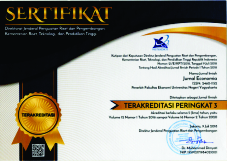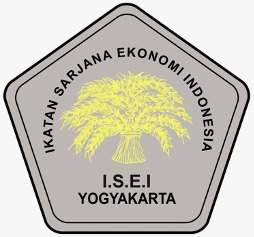The Determinants of Inclusive Economic Growth in Yogyakarta
Downloads
Abstract: Inclusive economic growth is related to how economic growth achieved can reduce poverty, income inequality, and unemployment. The purpose of this study is to analyze factors that influence inclusive economic growth in Yogyakarta. This study used panel data from 2011 to 2017. Estimation of the model (simultaneous equations) used the Two-Stage Least Square (2SLS) method. The result of the analysis showed that Factors that have a positive impact on inclusive economic growth are household consumption, exports of service/goods, foreign investment, domestic investment, per capita income, and average length of year of study. Whereas the negative influence is the level of open unemployment and imports of service/goods. An increase in household consumption by 2% willincrease gross regional domestic product by 1.5%, decrease the open unemployment rate by 3.0%, decrease poverty by 10.7%, and decrease income inequality by 5.5%.
Keywords: inclusive economic growth. simultaneous equations. 2SLS
Faktor-Faktor yang Mempengaruhi Pertumbuhan Ekonomi Inklusif di Yogyakarta
Abstrak: Pertumbuhan ekonomi dikatakan inklusif jika memberi manfaat bagi masyarakat bawah seperti dapat mengurangi kemiskinan, ketimpangan pendapatan, dan pengangguran. Tujuan dari penelitian ini adalah untuk menganalisis faktor-faktor yang mempengaruhi pertumbuhan ekonomi inklusif di Daerah Istimewa Yogyakarta. Penelitian ini menggunakan data panel dari tahun 2011 hingga tahun 2017. Estimasi model (persamaan simultan) menggunakan metode Two Stage Least Square (2SLS). Analisis menunjukkan bahwa faktor-faktor yang memiliki pengaruh positif terhadap pertumbuhan ekonomi inklusif adalah konsumsi rumah tangga, ekspor barang/jasa, investasi asing, investasi domestik, pendapatan perkapita, dan rata-rata lama sekolah. Sedangkan pengaruh negatifnya adalah tingkat pengangguran terbuka dan impor barang/jasa. Peningkatan konsumsi rumah tangga sebesar 2% akan meningkatkan produk domestik regional bruto sebesar 1.5%, menurunkan tingkat pengangguran terbuka sebesar 3.0%, menurunkan kemiskinan sebesar 10.7% dan menurunkan ketimpangan pendapatan sebesar 5.5%.
Kata kunci: pertumbuhan ekonomi inklusif. persamaan simultan. 2SLS
Downloads
Alekhina, V., & Ganelli, G. (2020). Determinants of Inclusive Growth in ASEAN. IMF Working Papers, 20(118), 1–39. https://doi.org/10.5089/9781513549194.001
Ali, I., & Son, H. H. (2007). Defining and measuring inclusive growth: Application to the Philippines. ERD Working Paper Series, 98, 1–44.
Ali, I., & Zhuang, J. (2007). Inclusive growth toward a prosperous Asia: Policy implications. ERD Working Paper Series, 97, 1–44.
Anand, R., Mishra, S., & Peiris, S. J. (2013). Inclusive Growth: Measurement and Determinants. IMF Working Paper, 13(135), 1–26.
Anwar, A. (2017). Peran Modal Manusia Terhadap Pertumbuhan Ekonomi Regional di Jawa. Jurnal Economia, 13(1), 79–94.
Asian Development Bank (ADB). (2011). Key Indicators for Asia and the Pacific 2011 : Framework of Inclusive Growth Indicators, Special Supplement. Asian Development Bank.
Azwar. (2016). Pertumbuhan Inklusif Di Provinsi Sulawesi Selatan Dan Faktor-Faktor Yang Mempengaruhinya. BPPK, 9(2), 216–242.
Badan Pusat Statistik. (2018). Daerah Istimewa Yogyakarta Dalam Angka 2018. Badan Pusat Statistik Propinsi D.I. Yogyakarta.
Dirgantoro, M. A., Mangkuprawira, S., Siregar, H., & Sinaga, B. M. (2009). Dampak kebijakan desentralisasi fiskal terhadap transformasi ekonomi di provinsi jawa barat. Organisasi Dan Manajemen, 5(1), 1–9.
Fithrian, M., Syechalad, N., & Nasir, M. (2015). Analisis Pengaruh Aggregat Demand Dan Tingkat Pendidikan Terhadap Ketimpangan Pendapatan Di Aceh. Ilmu Ekonomi Pascasarjana Universitas Syiah Kuala Mementingkan, 3(3), 23–32.
Gujarati, D. N., & Porter, D. C. (2010). Essentials of Econometrics Fourth Edition (4th ed.). McGraw-Hill.
Klasen, S. (2010). Measuring and monitoring inclusive growth in developing and advanced economies: Multiple definitions, open questions and some constructive proposals. Reframing Global Social Policy: Social Investment for Sustainable and Inclusive Growth, 12, 123–144.
Lee, N., & Sissons, P. (2016). Inclusive growth? The relationship between economic growth and poverty in British cities. Environment and Planning A, 48(11), 2317–2339. https://doi.org/10.1177/0308518X16656000
Lisna, V., Sinaga, B. M., Firdaus, M., & Sutomo, S. (2013). Dampak Kapasitas Fiskal terhadap Penurunan Kemiskinan: Suatu Analisis Simulasi Kebijakan. Jurnal Ekonomi Dan Pembangunan Indonesia, 14(1), 1–26. https://doi.org/10.21002/jepi.v14i1.433
McKinley, T. (2010). Inclusive growth criteria and indicators: an inclusive growth index for diagnosis of country progress. Asian Development Bank Working Paper, 14, 1–34.
Munir, F., & Ullah, S. (2018). Inclusive Growth in Pakistan : Measurement and Determinants. The Pakistan Journal of Social Issues, Special Issue, 150–162.
Nur, I., Mulatsih, S., & Asmara, A. (2013). Analisis Struktur Perekonomian Dan Faktor-Faktor Yang Memengaruhi Pertumbuhan Ekonomi Sumatera Selatan. Jurnal Ekonomi Dan Kebijakan Pembangunan, 2(1), 47–59. https://doi.org/10.29244/jekp.2.1.47-59
Okun, A. M. (1962). Potential GNP: its measurement and significance. In Proceedings of the Business and Economic Statistics Section of the American Statistical Association. American Statistical Association (pp. 98–104).
Pindyck, R. S., & Rubinfeld, D. L. (1997). Econometric models and economic forecasts (4th ed.). McGraw-Hill.
Prasetyo, B. A., Priyarsono, D. S., & Mulatsih, S. (2013). Infrastructure, Economic Growth, And Inequality In Indonesia Land Borders. Economic Journal of Emerging Markets, 5(2), 99–108.
Quy, N. H. (2016). Relationship between Economic Growth, Unemployment and Poverty: Analysis at Provincial Level in Vietnam. International Journal of Economics and Finance, 8(12), 113–119. https://doi.org/10.5539/ijef.v8n12p113
Rambeli, N. B., Marikan, D. A. A., & Hashim, E. (2016). The Effect of Foreign Direct Investment, Exports and Employment on Economic Growth Model. International Journal of Academic Research in Business and Social Sciences, 6(11), 361–376. https://doi.org/10.6007/ijarbss/v6-i11/2405
Rindayati, W., Hutagaol, M. P., & Siregar, H. (2007). Dampak Desentraliasai Fiskal Terhadap Kinerja Fiskal Daerah Dan Ketahanan Pangan Di Wilayah Provinsi Jawa Barat. Jurnal Manajemen Dan Agribisnis, 4(2), 103–117.
Satrio, M. K., Amar, S., & Aimon, H. (2019). Determinants of Inclusive Growth on the Inequality. Advances in Economics, Business and Management Research, 97(Piceeba), 138–148. https://doi.org/10.2991/piceeba-19.2019.17
Sholihah, D. H. A., Hutagaol, M. P., & Asmara, A. (2018). Pertumbuhan Inklusif : Fenomena Pertumbuhan Inklusif Di Kawasan Indonesia Bagian Barat Dan Indonesia Bagian Timur. Jurnal Ekonomi Dan Kebijakan Pembangunan, 2(2), 85–112. https://doi.org/10.29244/jekp.2.2.85-112
Sipahutar, M. A., Oktaviani, R., Siregar, H., & Juanda, B. (2016). Effects of Credit on Economic Growth, Unemployment and Poverty. Jurnal Ekonomi Pembangunan: Kajian Masalah Ekonomi Dan Pembangunan, 17(1), 37–49. https://doi.org/10.23917/jep.v17i1.1651
Sukanto, S. (2015). Fenomena Inflasi, Penganguran Dan Pertumbuhan Ekonomi Di Indonesia: Pendekatan Kurva Philips Dan Hukum Okun. Jurnal Ekonomi Pembangunan, 13(2), 96–106. https://doi.org/10.29259/jep.v13i2.4859
Sulistyowati, N., Sinaga, B. M., & Novindra, N. (2017). Impacts of Government and Household Expenditure on Human Development Index. Jejak, 10(2), 412–428. https://doi.org/10.15294/jejak.v10i2.11305
Sungkar, S. N., Nazamuddin, & Nasir, M. (2015). Pengaruh Upah Minimum Terhadap Ketimpangan Pendapatan Di Indonesia. Jurnal Ilmu Ekonomi, 3(2), 40–53.
Wahyuni, I. G. A. P., Sukarsa, M., & Yuliarmi, N. (2014). Pengaruh Pengeluaran Pemerintah Dan Investasi Terhadap Pertumbuhan Ekonomi Dan Kesenjangan Pendapatan Kabupaten/Kota Di Provinsi Bali. E-Jurnal Ekonomi Dan Bisnis Universitas Udayana, 3(8), 91–101.
Wibowo, D. A. (2014). Pengaruh Pembiayaan Pendidikan, Tingkat Pendidikan, Pertumbuhan Ekonomi Dan Kemiskinan Di Jawa Tengah. Jurnal Economia, 10(2), 133–140. https://doi.org/10.21831/economia.v10i2.7539
Wirawan, I. M. T., & Arka, S. (2015). Analisis Pengaruh Pendidikan, PDRB Per Kapita Dan Tingkat Pengangguran Terhadap Jumlah Penduduk Miskin Provinsi Bali. E-Jurnal EP Unud, 4(5), 546–560.
World Bank. (2018). Riding the wave An East Asian Miracle for the 21st Century. World Bank East Asia and Pacific Regional Report. In World Bank. World Bank.
Xu, S., Huo, L., & Shang, W. (2015). The impact of wage distributions on economic growth based on multi-agent simulation. Procedia Computer Science, 55(Itqm), 809–817. https://doi.org/10.1016/j.procs.2015.07.155















